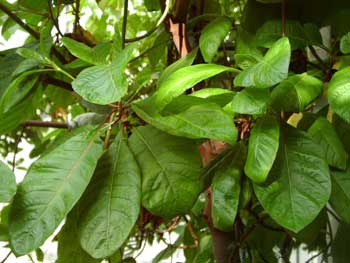Contents:
Common Names | Parts Usually Used | Plant(s) & Culture | Where Found | Medicinal Properties | Biochemical Information
Legends, Myths and Stories | Uses | Formulas or Dosages | How Sold | Warning | Bibliography
Scientific Names

- Cinchona officinalis L.
- Cinchona calisaya L.
- Cinchona succirubra L.
- Rubiaceae
- Madder family
Common Names
- Cinchona
- Cinchona bark
- Jacket bark
- Jesuits’ bark
- Yellow bark
- Yellow cinchona
- Yellow Peruvian bark
Parts Usually Used
Bark
Back to Top
Description of Plant(s) and
Culture
Various species of the evergreen cinchona tree; the branches bear opposite, elliptic-obovate leaves and fragrant, rose or purple colored flowers resembling lilac blossoms. Cinchona bark, varying in color with each species, can be removed from the tree in strips without harming the tree.
Back to Top
Where Found
Found in Peru and Equador, now grown more widely in tropical America, in India, and in the Orient.
Back to Top
Medicinal Properties
Antiperiodic, aperient, astringent, febrifuge, oxytocic, tonic
Back to Top
Biochemical Information
Catechins combined with 20 alkaloids which include quinine, quinidine, cinchonine, and cinchonidine
Back to Top
Legends, Myths and Stories
As is well known, quinine often causes deafness, but this bark used in its natural state is harmless. It exerts an excellent influence on the entire nervous system.
Back to Top
Uses
The greatest value of Peruvian bark is in its quinine content, which makes it effective against malarial infection. Small doses are also good for fever (drink the tea freely for fevers), neuralgia, epilepsy, pneumonia, typhoid, diarrhea, dysentery, blood purifier, rheumatic pains, and for indigestion. Makes a good mouthwash and gargle for mouth and throat problems. It stimulates uterine contractions; should not be used during pregnancy; unless uterine contractions are desired to aid in a tardy delivery.
Back to Top
Formulas or Dosages
Use in small doses only, preferably with medical supervision.
Cinchona bark may be taken as a powder, tincture, or in wine.
Infusion: steep 1 tsp. bark in 1 cup boiling water. Take 1/2 cup a day, no more than 1 to 2 cups total.
Tincture: take 5 to 30 drops at a time.
Back to Top
How Sold
Tablets, capsules
Back to Top
Warning
Peruvian bark stimulates uterine contractions; should not be used during pregnancy; unless uterine contractions are desired to aid in a tardy delivery. Use with medical direction and supervision only during pregnancy.
Back to Top
Bibliography
![]() American Folk Medicine
American Folk Medicine, by Clarence Meyer, Meyerbooks, publisher, PO Box 427, Glenwood, Illinois 60425, 1973
![]() Back to Eden
Back to Eden, by Jethro Kloss; Back to Eden Publishing Co., Loma Linda, CA 92354, Original copyright 1939, revised edition 1994
![]() The Herb Book
The Herb Book, by John Lust, Bantam Books, 666 Fifth Avenue, New York, NY. copyright 1974.
![]() Indian Herbalogy of North America
Indian Herbalogy of North America, by Alma R. Hutchens, Shambala Publications, Inc., Horticultural Hall, 300 Massachusetts Avenue, Boston, Massachusetts 02115, 1973
![]() Planetary Herbology
Planetary Herbology, by Michael Tierra, C.A., N.D., O.M.D., Lotus Press, PO Box 325, Twin Lakes. WI 53181., Copyright 1988, published 1992
![]() The Yoga of Herbs: An Ayurvedic Guide to Herbal Medicine
The Yoga of Herbs: An Ayurvedic Guide to Herbal Medicine, by Dr. David Frawley & Dr. Vasant Lad, Lotus Press, Twin Lakes, Wisconsin, Second edition, 1988.
![]() Webster’s New World Dictionary
Webster’s New World Dictionary, Third College Edition, Victoria Neufeldt, Editor in Chief, New World Dictionaries: A Division of Simon & Schuster, Inc., 15 Columbus Circle, New York, NY 10023
